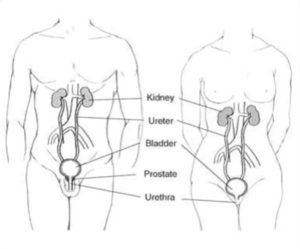What is CKD (chronic kidney disease)?
Keep track of your kidney data with PKB
Chronic kidney disease (CKD) is a long-term condition where the kidneys do not work as well as they should, or are damaged in some way.
It affects 10% of the population.

The kidneys are part of the urinary tract.
The disease is called ‘chronic’ because the damage to your kidneys happens slowly over a long period of time – usually over months or years.
This damage can cause wastes to build up in your blood and body; or some other evidence damage to the kidneys (e.g, protein in urine).
CKD can also cause other health problems, especially related to the heart and blood pressure. In most people it is a ‘silent disease’, i.e. they do not know they have it – like high blood pressure and early diabetes.
So. What is chronic kidney disease (CKD)?
Let’s start with a definition.
How is CKD defined?
Simple definition 1 (simple): a long-term condition where the kidneys do not work as well as they should, or are damaged in some way.
Precise definition 2 (more complex and accurate, used by doctors): with 2 types ..
- ‘Functional CKD’ = an estimated glomerular filtration rate (eGFR; see below) of <60 mL/min – that is present for at least three months (i.e. measured at least twice), with or without evidence of kidney damage; or,
- ‘Structural CKD’ = evidence of kidney damage with or without decreased GFR – that is present for at least three months, as shown (by 1 or more of):
-
- Albuminuria (protein in urine),
- Haematuria (blood in urine, after exclusion of urological causes),
- Structural abnormalities (e.g. polycystic kidneys) on renal ultrasound)
- Pathological abnormalities (e.g. on kidney biopsy)
- Electrolyte and other abnormalities due to tubular disorders
- History of kidney transplantation.
This definition is based on the 2024 KDIGO CKD guideline (Stevens, 2024).
Note. In other words, in some cases of CKD there is evidence of kidney damage but normal renal function (normal GFR and creatinine).
How common is CKD?
As we have said, about 1 in 10 people have CKD, i.e. its very common. Fortunately in most people, it is mild and more of a risk factor than disease.
However, in 1 in 100 people with CKD, kidney function gets worse over time, and develop kidney failure (stage 5 CKD). They will then need dialysis or a kidney transplant.
Age is the primary risk factor for CKD:
- CKD is present in 25% of people aged 65-74 years, and 50% in people over 75 years. In many of these it is really part of the ageing process and not a disease
- It is less common in young adults, being present in 1 in 50 people
- The average age range of starting dialysis is 60-65 years old.
Approximately 70,000 people in the UK are on dialysis or have a transplant, i.e. 1 in 1000 people. This means that each GP will have two such patients ‘on their books’.
Summary
We have described what is chronic kidney disease (CKD). This website is focused on chronic kidney disease. So, hopefully by reading our articles you will get a better understanding of what is chronic kidney disease.
Other resources
Here is a more precise definition of CKD. and these are the 5 stages of CKD.
https://www.youtube.com/watch?v=uTfa9Tia1A4&t=47s
Last Reviewed on 23 May 2024
